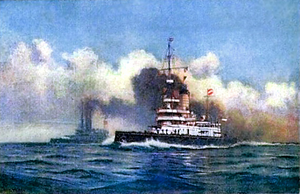SMS Monarch
 A painting showing SMS Wien and the other ships of the Monarch class on maneuvers
| |
| History | |
|---|---|
Austro-Hungarian Empire | |
| Name | SMS Monarch |
| Ordered | May 1892 |
| Builder | Pola Naval Arsenal |
| Laid down | 31 July 1893 |
| Launched | 9 May 1895 |
| Sponsored by | Archduchess Maria Theresa |
| Commissioned | 11 May 1898 |
| Decommissioned | 14 March 1918 |
| Fate | Scrapped, 1921 |
| General characteristics | |
| Class and type | coastal defense ship |
| Displacement | 5,785 tonnes (5,694 long tons) ( full load ) |
| Length | 99.22 m (325 ft 6 in) |
| Beam | 17 m (55 ft 9 in) |
| Draught | 6.4 m (21 ft 0 in) |
| Installed power |
|
| Propulsion |
|
| Speed | 17.5 knots (32.4 km/h; 20.1 mph) |
| Range | 3,500 nmi (6,500 km; 4,000 mi) @ 9 knots (17 km/h; 10 mph) |
| Complement | 26 officers and 397 enlisted men |
| Armament |
|
| Armour |
|
SMS Monarch
The division was sent to
Description and construction

At only 5,785 tonnes (5,694 long tons) maximum displacement,[1] the Monarch class was less than half the size of the battleships of other major navies at the time,[2] and were officially designated as coast defense ships.[3] Austria-Hungary's only coastline was on the Adriatic Sea, and the Austro-Hungarian government believed that the role of its navy was solely to defend the nation's coast.[2]
Monarch had an
The armament of the Monarch class consisted of
The ship's nickel-steel waterline armor belt was 120–270 millimeters (4.7–10.6 in) thick and the gun turrets were protected by 250 millimeters (9.8 in) of armor. The casemates had 80 millimeters (3.1 in) thick sides while the conning tower had 220 millimeters (8.7 in) of armor. Monarch's deck armor was 40 millimeters (1.6 in) thick.[7]
The Monarch-class ships were ordered in May 1892,
Service history
Monarch and her sisters formed the Navy's 1st Capital Ship Division (I. Schwere Division) in 1899, and the division made a training cruise to the Eastern Mediterranean where they made port visits in
The Monarchs were relegated to the newly formed Reserve Squadron on 1 January 1906, and were only recommissioned for the annual summer exercises. They participated in a fleet review by Archduke Franz Ferdinand, conducted in the
World War I

With the beginning of World War I the three Monarchs were recommissioned as the 5th Division. They were sent down to the
Monarch remained at Cattaro for the rest of the war to deter any further attacks. The ship's crew joined in the Cattaro Mutiny in early February 1918. Six weeks later she became an accommodation ship for the submarine crews based at nearby Gjenovic.[14] Monarch was handed over to Great Britain as war reparations in January 1920 and broken up for scrap in Italy in 1921.[14]
Notes
Explanatory notes
- Seiner Majestät Schiff", or "His Majesty's Ship" in German.
Citations
- ^ Sieche, p. 256.
- ^ a b Sokol, p. 67.
- ^ a b c Chesneau & Kolesnik, p. 272.
- ^ a b Noppen, pp. 6, 8.
- ^ Friedman, p. 294.
- ^ Sieche, p. 250.
- ^ Noppen, p. 8.
- ^ Sieche, p. 227.
- ^ Sieche, pp. 234, 240.
- ^ Sieche, pp. 234, 240, 245.
- ^ Sondhaus, p. 158.
- ^ Sieche, p. 245.
- ^ Sieche, pp. 245–46.
- ^ a b Sieche, p. 253.
References
- Chesneau, Roger; Kolesnik, Eugene M., eds. (1979). Conway's All the World's Fighting Ships 1860–1905. Greenwich, UK: Conway Maritime Press. ISBN 0-8317-0302-4.
- ISBN 978-1-84832-100-7.
- Noppen, Ryan (2012). Austro-Hungarian Battleships 1914–1918. New Vanguard. Vol. 193. Botley, Oxford, UK: Osprey Publishing. ISBN 978-1-84908-688-2.
- Sieche, Erwin F. (1999). "Austria-Hungary's Monarch Class Coast Defense Ships". Warship International. XXXVI (3). Toledo, Ohio: International Naval Research Organization: 220–260. ISSN 0043-0374.
- Sokol, Anthony (1968). The Imperial and Royal Austro-Hungarian Navy. Annapolis: United States Naval Institute. OCLC 462208412.
- Sondhaus, Lawrence (1994). The Naval Policy of Austria-Hungary, 1867–1918. West Lafayette, IN: Purdue University Press. OCLC 28112077.
Further reading
- Greger, René (1976). Austro-Hungarian Warships of World War I. London: Ian Allan. ISBN 0-7110-0623-7.
External links
